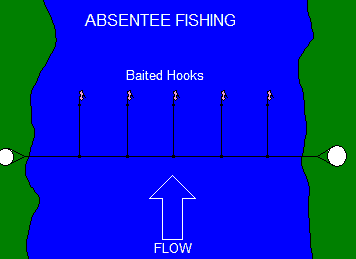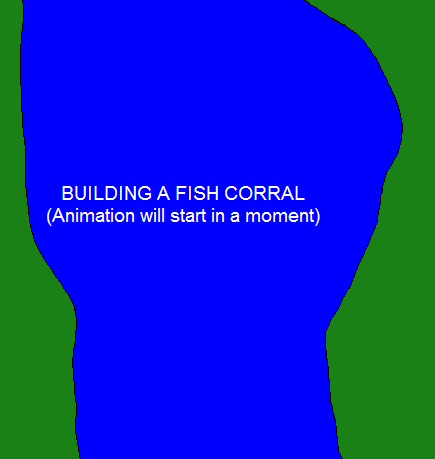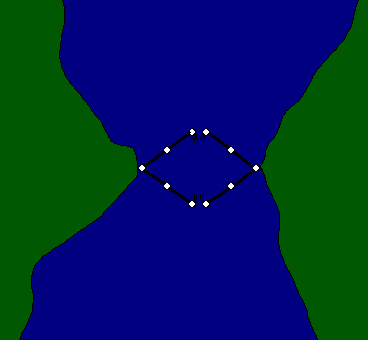
Survival Fishing
Survival fishing is quite different than normal fishing. Survival fishing is often done without you even being there. It's more akin to trapping and snaring than it is to conventional fishing. There are several ways in which this can be accomplished.
ABSENTEE FISHING
If you have fish hooks and line (in a survival kit), then you're way ahead of the game. You can bait a whole bunch of hooks, string them on a line across the waterway, and then walk away. This is "absentee fishing". Be careful that the line you string across the waterway is strong (550 cord works well). Tie it between a couple trees a couple feet above the water, and then you can either rely on the water flow to keep the bait near the surface, or simply put just enough line down to your hooks to not allow them to sink. If the water is moving, your bait will be dancing to entice the fish. If there's little or no movement, you can tie some leaf covered branches to the paracord to catch the wind, which also makes your bait look lively. While waiting for a catch, you can keep yourself busy with important things like fire and shelter, and simply check your lines every few hours.

FISH FENCES
If you don't have any hooks and line, then I recommend a "fish fence". A "fish fence" is just what it sounds like. It's a fence that you make out of sticks that will corral the fish for you. Below, you'll see a couple sections of fish fence. As you can see, the smaller twigs are woven back and forth between the posts, which holds it all together nicely. The denser the better, as long as water can flow through, and fish cannot! This is built on land in sections, and then inserted in a likely waterway by pushing the posts into the mud at the bottom.


There are several versions of this... it really depends on the waterway.
If it's a pond, and there's no flowing water, then you'll just make a corral in a shallow area with only one opening that funnels fish in. Once they're trapped in the small area, they can be speared or grabbed more easily.
If you're working with a stream, then it's important to determine the direction of flow. Observe whether fish are moving upstream, downstream, or both. If the fish are moving in one direction then a basic fence placed diagonally across the stream will concentrate the fish in a small area making it easier to spear one.
In the animation below, you can see the basic strategy used to corral fish.

If the fish are moving in both directions, you may want to make a "corral" that will catch in both directions as shown below. If you have built your fencing in sections, it's easier to try different configurations to see which works best for you.

In this picture, I show 4 fence sections across a narrow point in a stream. The points facing inward from the two openings are sharpened twigs. These ensure that once something comes into the corral, it is "encouraged" to stay there.
As always, plan twice and build it once! Before you build, make sure you know where you're going to put it, and how deep the water is. Shallow areas are best. There's less fence to build, but mainly it's the fact that you really don't want to go swimming after fish in November!
CLICK HERE TO RETURN TO PRIMITIVE HUNTING AND SNARING PAGE